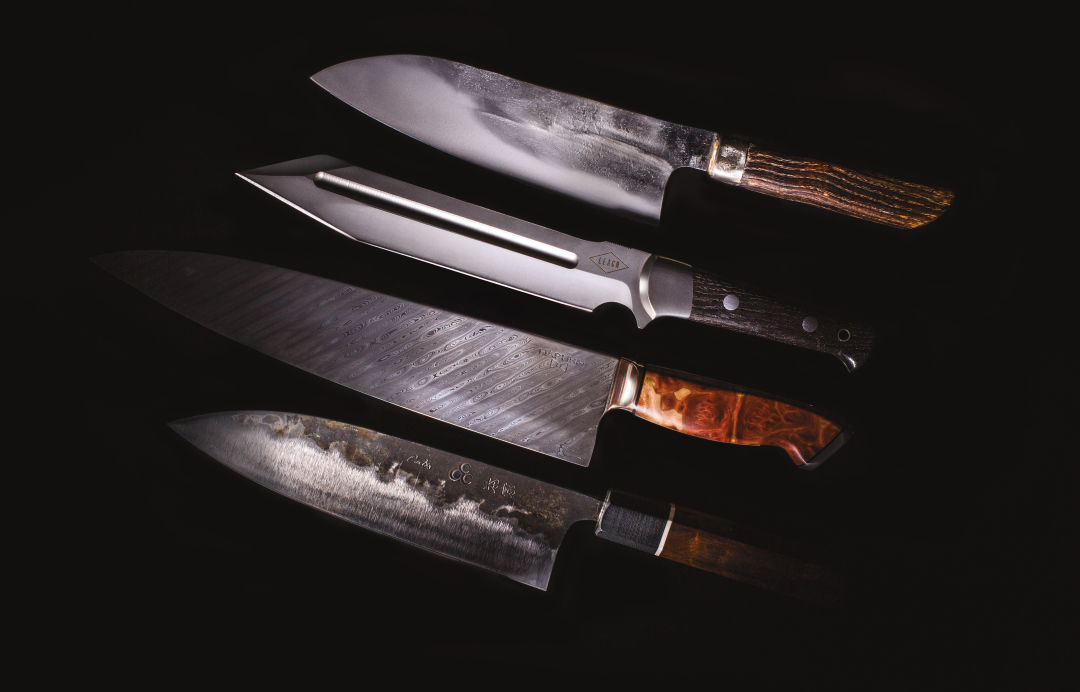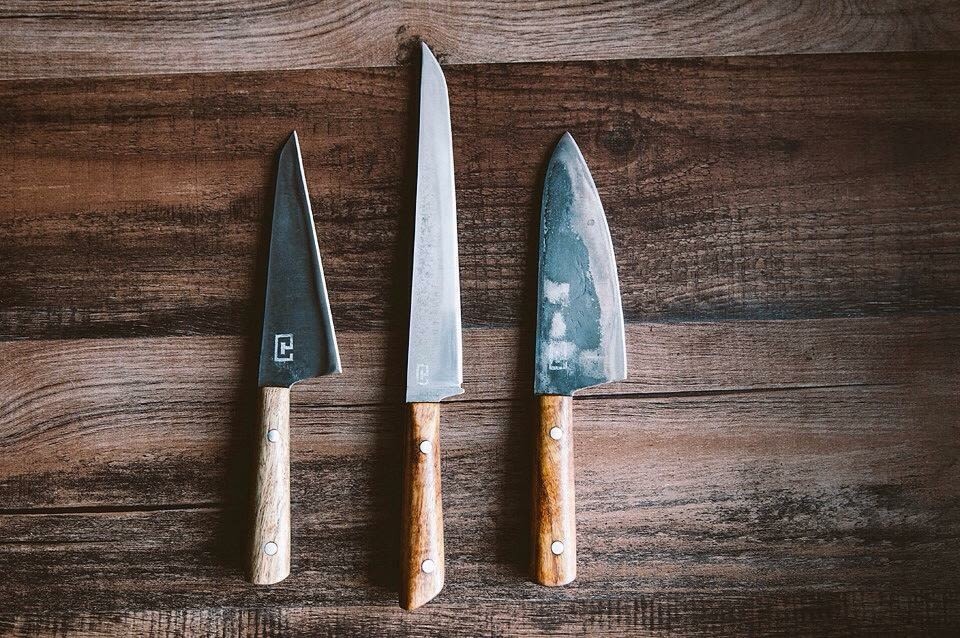Meet Portland's Master Bladesmiths

From top to bottom: Bridgetown Forge, Leach Knives, Haburn Knives, Carter Cutlery
Image: Michael Novak
The concrete floor of Murray Carter’s Hillsboro forge is thumping like a drum from the weight of his 55-pound spring hammer relentlessly smashing a block of hot steel. Sparks fly onto onlookers’ shoes as the percussive force compresses the air in the room into our ear canals. Fortunately, we’ve been given earplugs.
“It’s like a real-life Forged in Fire,” exclaims one woman, referring to the popular History Channel blacksmithing competition on which our host was, in fact, a contestant.
Indeed, Carter is the most recognizable name of a local bladesmithing movement. Early on, big outfits like Gerber, Leatherman, and Benchmade fostered talent. Now dozens of independent smiths stoke the scene’s coals. Here are five bladesmiths to know (pictured above, top to bottom).
Bridgetown Forge
Arnon Kartmazov’s philosophy on making knives is straightforward:
“First is simplicity," he says. "I don’t hold with any sort of decoration. Second is complete functionality. Next is ergonomics—not ergonomics just for the eye, but also the hand. And the heart.”
Originally from Siberia, Kartmazov’s family moved to Israel when he was young, where he entered his first smithing apprenticeship. Studies in linguistics took him to Japan, where he eventually gave up languages to pursue smithery, which he found more difficult but more satisfying.
A hammered ridge near the bolster (where the blade connects to the handle) and a scorched hickory handle lend his knives a primal, medieval look. They feel wonderfully organic and lively in the hand.
“Form follows function,” says Kartmazov, 54. “It’s beautiful because it’s sharp.” Starting at $135
Leach Knives
Justin Leach spent many a childhood summer in the rural West, playing and working outside. So it’s no surprise the 38-year-old has always been attracted to the most fundamental of tools. When he set out to make his own a few years ago, he initially gravitated to an Old West aesthetic.
“But,” he says, “my real draw is toward the camp knife—thicker stock, hollow ground bevels,” with tactical touches like titanium bolsters and black bog oak handles.
He brings that tactical look and feel to his elegant kitchen knives, but with a lighter weight in the hand, since you probably won’t have to repurpose this gorgeously satin nine-inch fillet knife as a hammer. Starting at $300
Haburn Knives
Damascus steel consists of two different metals, usually steel formulations, forged and folded together over and over, building up intricate layers, visible in the final product as undulating patterns running the length of the blade.
A former aerospace designer, Ian Rogers, 35, performs creative experiments with Damascus processes to create kaleidoscopic patterns in his higher-end blades. He pairs these intricate masterpieces with old and new handle materials—mammoth tooth, buckeye burl, carbon fiber—to create cutlery that wouldn’t embarrass a display case. But that’s not what he makes them for.
“I just want to make the most beautiful functional tools that I can,” he says. “That’s why I gravitate towards kitchen knives.” Starting at $700
Carter Cutlery
Murray Carter was chosen to carry a 16-generation Japanese bladesmithing tradition into its 17th generation. He’s probably the first Westerner to do so. He’s also an American Bladesmith Society Master Smith, which requires forging a knife that can cut hemp rope while retaining an edge you can still shave with.
With 30 years of experience and more than 25,000 knives made, Carter, 48, talks a lot about “a perfect knife,” his shorthand for “as perfect as has ever been made.” He uses a laminated steel—an extremely tough, high-carbon core steel that’s clad with softer steel for maximum flexibility and strength—from suppliers in Japan, and heats his forge with Japanese pine charcoal; hammering it out with a Japanese spring. He grinds the resulting blades “as thin as we dare.” Starting at $110

Trent Turvey Designs
Image: Courtesy Trent Turvey
Trent Turvey Designs
Trent Turvey, 42, climbs up into the top of a derelict old lumber mill near Battle Ground, Washington, to harvest pieces of an old band saw from which he crafts his cutlery and fixed blade pocket knives and hunting knives.
“I like seeing the history in the steel that I use,” Turvey says.
Despite nearly 60 years of neglect, these saw blades still sport sharp teeth. They were made from L6, a high-carbon tool steel that’s quite flexible and extremely tough. (It was made to cut through trees.) Above the bevel, the pits and stains of the old saw blade remain.
The result is a sturdy knife with warmth and character. Turvey’s knives are a little more substantial than your average custom blade, and the geometry is a little exaggerated (big bellied chef’s knives, for example), so let that knife do a little of the work for you. Starting at $115
Knife 101
Weight
In the parlance of knife forums, knives are generally classed as lasers or workhorses. Lasers are light and flexible, but also more delicate and potentially fragile. A workhorse is heavier and sturdier. Many high-end knives comfortably straddle the line.
Balance
A well-balanced knife will have a fulcrum point near the bolster. It should feel lively in the hand.
Handles
Handle selection is intensely personal. Wa handles are octagonal—traditional on Japanese cutlery. D handles are asymmetrical and not ambidextrous.
Steel
In general, high-carbon steel more readily takes and maintains a fine edge, but is prone to corrosion without care. Acidic foods especially can corrode the blade. Stainless takes less care, but is generally harder to sharpen. Damascus steel, named after the legendary sword steel associated with Damascus, Syria, involves forging together and repeatedly folding two different alloys, building up hundreds of layers revealed in the finished product as undulating lines running the length of the blade. In laminated steel, a layer of harder carbon steel is sandwiched between softer, generally more corrosion-resistant steel. The result is flexibility with a fine, wear-resistant edge.




